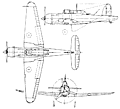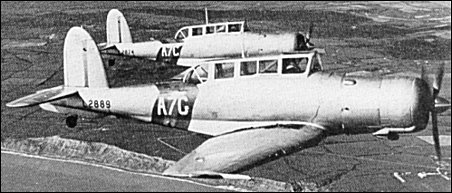|
| The Skua was the Fleet Air Arm's first fighter/dive-bomber and its first operational monoplane. The Skua was also the first radial-engined all-metal cantilever low-wing monoplane with folding wings, flaps, a retractable landing gear and variable-pitch propeller to be produced in Britain. It was first flown in prototype form on 9 February 1937. The crew of two sat in a glazed cabin, the rear-gunner being armed with one Lewis gun and the pilot with four Browning guns mounted in the wings. One 227kg armour-piercing bomb was carried under the fuselage.
To meet the Royal Navy's ugent requirements 190 Skuas were ordered in July 1936 (six months before the prototype flew) and deliveries were completed in March 1940. Skuas re-equipped Nos 800 and 803 Squadrons on board the aircraft carrier HMS Ark Royal and No 801 on board HMS Furious. A Dornier Do 18 flying-boat - the first enemy aircraft shot down during World War II by the FAA - fell to the guns of a Skua of No 803 Squadron piloted by Lt B. S. McEwen off Heligoland on 25 September 1939. Although quickly replaced as a fighter, it was a very effective dive-bomber, its greatest success being the sinking of the German cruiser Konigsberg in Bergen Harbour on 10 April 1940, which was attacked by seven Skuas of No 800 Squadron led by Capt R. T. Partridge RM and nine Skuas of No 803 Squadron led by Lt W. P. Lucy RN. This involved a long-distance night crossing from Hatston, Orkney. The majority were lost 11 days later when both squadrons embarked on Ark Royal to cover the Narvik operations.
In June 1940 No 801 Squadron operated over the Dunkirk beaches from a temporary base at Detling, Kent. After brief operations on board Ark Royal and Argus in the Mediterranean, Skuas were relegated to target-towing in distinctive diagonal black and yellow stripes.

| MODEL | B-24 Skua II |
| CREW | 2 |
| ENGINE | 1 x Bristol Perseus XII, 664kW |
| WEIGHTS |
| Take-off weight | 3732 kg | 8228 lb |
| Empty weight | 2490 kg | 5490 lb |
| DIMENSIONS |
| Wingspan | 14.07 m | 46 ft 2 in |
| Length | 10.85 m | 36 ft 7 in |
| Height | 3.81 m | 13 ft 6 in |
| Wing area | 28.98 m2 | 311.94 sq ft |
| PERFORMANCE |
| Max. speed | 362 km/h | 225 mph |
| Cruise speed | 266 km/h | 165 mph |
| Ceiling | 6160 m | 20200 ft |
| Range | 1223 km | 760 miles |
| ARMAMENT | 5 x 7.7mm machine-guns, 340kg bombs |
 | A three-view drawing (674 x 606) |
| Anonymous, 25.09.2022 00:49 The first Skua prototype was powered by a Bristol Mercury engine. However, that version was cancelled because the Mercury engines were required for use in the Bristol Blenheim light bomber, the production of which was considered to be of higher priority. As a result, the Skua had to be re-designed to take the Bristol Perseus engine. The entire forward fuselage had to be altered. That was one of the reasons why development too so long, and it entered service so late. reply | | Trevor Webb, e-mail, 20.12.2013 13:24 No reference has been made to the Skua 1.This had the Bistol Mercury engine but was only built in protype form.Its bomb load was one 500 lb (227Kg) or 8 practice bombs on wing racks each 30 lb or 50 lb. reply | | VinceReeves, 05.03.2013 20:53 The Skua was primarily designed as dive bomber. It's role as a fighter was secondary. Please read Peter C. Smith's "Skua!" for confirmation.
It was certainly an effective dive bomber, though it was no longer best in class by the time it entered service. It was undoubtedly a good aircraft though, probably the most effective offensive British aircraft of 1939-40.
It was only prematurely retired by Somerville for operational reasons. If Britain had had more hanger space in its carriers, it would have served much longer. reply | | Klaatu83, e-mail, 24.09.2012 00:41 This was the Fleet Air Arm's first monoplane but it entered service so late (1939), that it was already almost obsolete before it became operational. The Skua was supposed to be a combination fighter and dive-bomber, but as a fighter it was under-armed and under-powered, and as a dive-bomber it was short on range and bomb-load. One can see the FAA's point in that, with limited space available on their carriers, they should want to acquire airplanes that could carry out more than one mission. Nevertheless, the Skua was a case of compromise which resulted in a multi-role aircraft that performed none of it's assigned roles satisfactorily. reply | |
| | Matthew Kitchen, e-mail, 15.09.2012 10:12 In my honest opinion; I don't like this plane. With all due respect; I think it was a piece of junk. The Swordfish or the Barracuda would easily outclass it. reply | | karl hecks, e-mail, 30.03.2011 17:54 H.J.Steiger was Swiss (one source says Danish) and worked for Beardmore before becoming chief designer of Blackburn Aircraft. He devised a monospar wing, the spar being of Warren girder form. A version of this wing, built by Blackburn was tested on a Lysander. Steiger also developed a form of double slotted flap. reply | | deaftom, e-mail, 27.03.2011 06:12 Poking around further into the British section of this site, I have run across the Hillson Bi-Mono (q.v.), which was yet another experiment with a slip-wing design, abeit this time with a purpose-built experimental aircraft. reply | | deaftom, e-mail, 24.03.2011 03:44 Regarding the slip-wing, I have read at least one historical article on an experimental slip-wing fitted to a Hawker Hurricane, probably the "circa 1940 concept" that you are referring to; unfortunately, I don't have a record of when or where that article was. It most likely was in either Aeroplane Monthly or possibly Air International, back in the 1980s or 1970s. Perhaps one of the more extensive histories of the Hawker Hurricane will have something about the slip-wing experiment.
I do have a reference to a Pemberton-Billing proposal for a "push-pull" fighter with a biplane slip-wing, in Air Enthusiast #51, page 7. Hope this helps. reply | | deaftom, e-mail, 24.03.2011 03:33 It may be too late to help you now, but there is an article referencing a Lysander II fitted with the Blackburn-Steiger High Lift Wing, in the American aviation magazine Air Classics, December 1981, pages 70-73. reply | | Taffwob, e-mail, 01.04.2010 17:14 Nice looking aircraft that could have been more useful with a better engine. A British contemporary of the venerable SBD Dauntless. reply | | Tony Pay, e-mail, 02.11.2007 17:26 I am trying to trace "Steiger's" Blackburn connection, indeed almost anything about the man.
My immediate interest is in the Steiger wing, tested on a modified Lysander, and a "slip-wing" concept circa 1940. Can you please help, or point me in the right direction - I have not even been able to find his first name!
Thanks in advance- even if you can't help!
Tony Pay reply |
|
Do you have any comments?
|
| 
COMPANY
PROFILE
All the World's Rotorcraft
|








